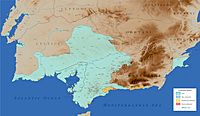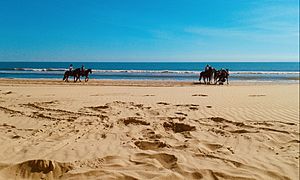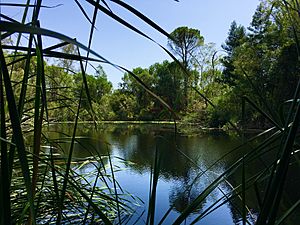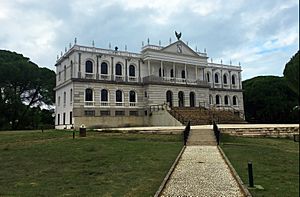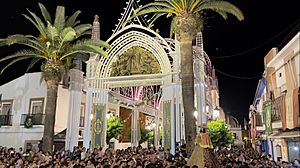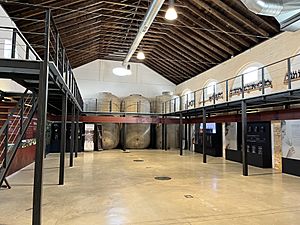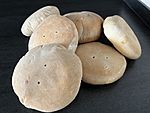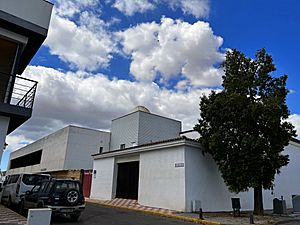Almonte, Spain facts for kids
Quick facts for kids
Almonte
|
|||
|---|---|---|---|
|
town and municipality
|
|||
|
From top, left to right: Alcalde Mojarro Park, the church, the main square, the entrance of the fair and the main business avenue.
|
|||
|
|||
| Municipality | Huelva | ||
| Area | |||
| • Total | 861 km2 (332 sq mi) | ||
| • Land | 861 km2 (332 sq mi) | ||
| • Water | 0.00 km2 (0 sq mi) | ||
| Population
(2018)
|
|||
| • Total | 24,013 | ||
| • Density | 27.890/km2 (72.23/sq mi) | ||
| Time zone | UTC+1 (CET) | ||
| • Summer (DST) | UTC+2 (CEST) | ||
Almonte is a town and municipality in southwestern Spain. It is located in the province of Huelva. In 2022, about 25,448 people lived there. This makes it the third-largest town in its province. Only Huelva, the capital, and Lepe are bigger.
Almonte is huge, covering 859.21 square kilometers (331.74 sq mi). It is the 19th largest municipality in Spain. The town is 75 meters (246 ft) above sea level. It is also about 50 kilometers (31 miles) from Huelva.
Almonte is famous for the village of El Rocío. This village influenced the American Wild West culture. It also hosts one of the world's most popular pilgrimages. A large part of the Doñana National Park is in Almonte. This park is Europe's biggest nature reserve and a World Heritage Site by UNESCO. Spain's longest beach, including Matalascañas beach, is also here. Almonte is a top exporter of organic fruit in Spain. It is also the number one blueberry exporter in Europe.
Contents
- A Glimpse into Almonte's Past
- People of Almonte
- Exploring Almonte's Geography
- Almonte's Culture and Traditions
- Almonte's Economy, Resources, and Transport
- Science and Technology in Almonte
- See also
A Glimpse into Almonte's Past
Almonte has a long and interesting history. It was part of important events like the Discovery of America and the Napoleonic Wars. In the 1500s, the town bought the "Las Rocinas" woods. This connected Almonte to the Atlantic coast and later to Doñana National Park. Even though Almonte was officially founded in the 1200s, people have lived here since prehistoric times.
Prehistoric Times
Long ago, a region called Tartessia existed here. Remains from the Bronze Age have been found in Almonte. These include old tools near the San Bartolomé stream. People believe this ancient village focused on making and trading silver. Its buildings were oval-shaped huts made of sticks and mud. This settlement might have traded with Greeks and Phoenicians. It was near a large lake, which dried up around 700 BC.
Ancient Roman History
Romans also lived in this area. An old Roman town called Alostigi might have been where Almonte is today. Archaeologists found a factory for making garum (a fish sauce) near Cerro del Trigo. This area is now part of Doñana National Park. At least 15 other factories were found along Almonte's coast. They also found a Roman necropolis (a burial ground) and old coins.
The Middle Ages
The town of Almonte was officially started in the 700s AD. It was first called Al-Yabal, meaning "the Mount." Later, it was known as Al Munt. The Umayyads, an ancient dynasty, were the first to train the wild horses here. These horses are now a protected species.
In the early 1200s, the Crown of Castile took over Almonte. After a big rebellion, the area became part of the Kingdom of Seville. King Alfonso X "The Wise" ordered the first church for Saint Mary of Las Rocinas to be built in 1270. This became the famous Virgin of El Rocío sanctuary. The statue of the Virgin is an old Gothic sculpture from the 1100s.
In 1335, a nobleman named Alvar Pérez de Guzmán became the owner of Almonte. Later, Almonte and Niebla fought over land. The Duke of Medina Sidonia finally set the borders.
Modern History
Trade grew in Almonte during the discovery of America. Christopher Columbus sailed from a nearby port. Olive oil was a main export from Almonte. This busy trade also made people more interested in the Virgin of El Rocío. Recent research shows that the village of El Rocío was an important medieval river port.
Almonte also influenced American colonies, especially in the Wild West. The sandy roads and wooden rails for tying horses in El Rocío were likely brought to the United States. The Mustang horse breed also came from this area. Its name comes from the Spanish word "mostrenco," meaning "wild."
In the 1500s, the duke bought the Las Rocinas woods. This doubled Almonte's size and made it a coastal town. These woods later became a Royal forest and were renamed Doñana. Spanish kings and queens often visited Doñana.
In 1583, Almonte bought Doñana from the duke. This allowed locals to expand farming and fishing. In 1598, the Virgin was brought to Almonte for the first time. This became a tradition during crises. A Confraternity (a religious group) was also officially started that year. "Saint Mary of Las Rocinas" became Almonte's patron saint in 1653. Many towns joined this group over time, even from other countries.
The Great Lisbon earthquake in 1755 damaged the coast. Many fortified towers built to protect the shores were destroyed. At least six of these towers were in Almonte. Most still stand, except for Torre de la Higuera. This tower is upside down and is a symbol of the town. The El Rocío church was also damaged and rebuilt.
During the 1700s and 1800s, people in Almonte farmed olives, grapes, and raised animals. Its large territory meant people always had resources.
In 1810, during the war against France, a French captain was executed in Almonte. French soldiers came to get revenge. But they never reached Almonte. People believed the Virgin helped them. To show thanks, they started an annual celebration called "El Rocío Chico" every August.
Since 1949, the Virgin has been brought from El Rocío to Almonte every seven years. She stays for nine months. This event brings hundreds of thousands of people to town. It requires a big security plan.
In the 1940s, many trees were planted in Almonte. Over 30,000 hectares were replanted with different types of trees. A forest village called "Los Cabezudos" was built. It had a school, church, and shops. Engineers and foresters lived there. They worked extracting wood and oil from trees. Cabezudos became empty in the late 1980s. It is now a ghost town and protected.
Today, Almonte is known for El Rocío, the Doñana National Park, its long sandy beach, and its organic berry industry.
People of Almonte
Almonte's population grew a lot in the 1960s. Foresters and their families moved from nearby forest villages. Another big increase happened in the 2000s. Many immigrants from different countries, especially Romania and Morocco, arrived. They make up almost 20% of the population.
In 2007, Almonte became the third most populated town in its province. This was partly due to Matalascañas, Almonte's summer resort. It has about 3,000 permanent residents. The village of El Rocío has around 1,700 people.
Exploring Almonte's Geography
The main town area of Almonte covers 3.2 square kilometers. It has different parts, or districts.
Town Districts
The Centre
The main business and political area is in the north. It has the town hall (a 1600s building), the main square, and the church (from the 1400s). You can also find the museum, theater, library, and music school here.
Northern Area
This area has grown since the 1960s. It has wide streets and boulevards. The main sport center is here, along with two high schools. You can also visit Alcalde Mojarro Park, the Wine Museum, and a science center with an astronomy observatory.
Western Area
This part of town has also grown since the 1960s. The A-484 road became a main business street called "Carretera del Rocío." It's over 1 kilometer long. Many restaurants and shops are on this street. This area also has the health center and several monuments.
Eastern Area
This area includes the fairground and Plaza de España square. You'll find the Padel center, the Official Language School, and the Flamenco school here. Many shops and cafes are also in this zone.
Southern Area
This is the fastest-growing area. It has the "El Tomillar" industrial estate with many businesses. There's another sport center and two parks. This district gets very busy during the El Rocío pilgrimage. Its main street leads to the village of El Rocío.
El Rocío and Matalascañas
The village of El Rocío is 15 kilometers (9 miles) south of Almonte. It's a rectangular town next to a marsh, right by the Doñana National Park. It has straight streets and about 1,000 permanent residents. Its unique style and horse culture were brought to the American Wild West. A large new hospital is being built here, which will be a major health and security center.
Matalascañas resort is 26 kilometers (16 miles) south of Almonte, on the Atlantic coast. It was built in the 1950s. About 3,000 people live here permanently. It has houses, hotels, restaurants, and a golf course. The lighthouse, built in 1994, is known for its unique triangular shape.
Where Almonte is Located
Almonte is one of Spain's largest municipalities. It's in southeastern Huelva, part of the Costa de la Luz. Almonte has Spain's longest straight sandy beach, stretching 50 kilometers (31 miles). 28 kilometers of this beach are protected as part of the Doñana National Park. Only 4 kilometers are developed for the Matalascañas resort. The sand is light and fine. There's also "El Asperillo," Europe's highest dune cliff, which is a Natural Monument.
Almonte shares borders with other towns. To its north is Bollullos Par del Condado. To the east is Hinojos. The Guadalquivir river and Sanlúcar de Barrameda are to the southeast. Rociana del Condado and Moguer are to the west. The Atlantic Ocean is to the south.
| Northwest: Rociana del Condado | North: Bollullos Par del Condado | Northeast: Hinojos |
| West: Moguer |  |
East: Hinojos |
| Southeast Moguer | South: Atlantic Ocean | Southeast: Sanlúcar de Barrameda |
Almonte's Weather
Almonte has a mix of Mediterranean and oceanic climates. This is because it's near both the Atlantic Ocean and the Mediterranean Sea. The average temperature is 17°C (62.6°F). Summers are warm, and winters are mild. It doesn't rain much, only about 700mm a year.
Heavy storms can hit the coast in winter, causing damage. The town council spends a lot of money to rebuild damaged areas.
| Month | Jan | Feb | Mar | Apr | May | Jun | Jul | Aug | Sep | Oct | Nov | Dec | Year |
|---|---|---|---|---|---|---|---|---|---|---|---|---|---|
| Mean maximum °C | 15.2 | 16.6 | 19.2 | 21.5 | 25.7 | 30.8 | 33.8 | 34.1 | 29.7 | 24.6 | 18.6 | 15.6 | 23.80 |
| Mean daily minimum °C | 6.2 | 6.9 | 9.1 | 11.1 | 14.3 | 18.5 | 20.6 | 21.2 | 18.5 | 15 | 7.3 | 7.6 | 13.25 |
| Average precipitation mm | 54 | 27 | 58 | 56 | 35 | 8 | 1 | 3 | 27 | 75 | 60 | 78 | 505 |
| Mean daily minimum °F | 43.2 | 44.4 | 48.4 | 52.0 | 57.7 | 65.3 | 69.1 | 70.2 | 65.3 | 59 | 45.1 | 45.7 | 55.85 |
| Average precipitation inches | 2.1 | 1.1 | 2.3 | 2.2 | 1.4 | 0.3 | 0.0 | 0.1 | 1.1 | 3.0 | 2.4 | 3.1 | 19.9 |
| Average precipitation days | 5 | 4 | 5 | 5 | 0 | 0 | 0 | 0 | 3 | 6 | 5 | 5 | 38 |
| Source: Climate Data | |||||||||||||
Almonte faces environmental challenges because of the Doñana National Park. There are concerns about water use for berry farms. In 2022, Almonte received a large investment for solar panels. This will help the area become a leader in renewable energy in Europe. The Spanish government also announced a big investment to restore parts of the Doñana National Park.
Plants and Animals
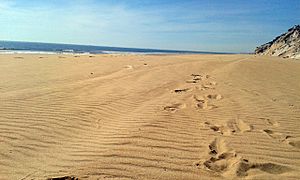
The Doñana National Park and its surroundings are home to many plants and animals. Some are endangered. You can find Mediterranean plants like pines, eucalyptus, and rosemary. Animals include the rare Iberian lynx, deers, wild boars, foxes, and many types of birds. The park has different areas, from jungles to desert dunes and wetlands. In 2022, Almonte was named a “Hub of European Biodiversity.”
Almonte's Culture and Traditions
Almonte has a rich history and unique customs. Different groups of people, from ancient times to the Middle Ages, have shaped its traditions. These traditions often focus on the area's natural resources. Today, Almonte's culture and nature attract many visitors from all over the world.
Historical Treasures
Almonte has many historical sites, from the Bronze Age to modern times.
Ancient Footprints
On Almonte's shore, near a restaurant, fossil footprints of extinct animals were found. They are about 100,000 years old. You can see them when the tide is low. An environmental group offers free tours to see these tracks. Recent research confirmed that some humanoid footprints belong to Neanderthals.
Neolithic Remains
Near a bridge south of town, tools and structures from the Neolithic period (around 5,000 BC) were found. These included adobe huts and tools made of stone.
Prehistoric Whistle
In January 2024, a prehistoric musical instrument was found near Santa Olalla lake. It's a Turdetani whistle from 2,000 BC. It's made of terracotta and shaped like a woman. It might have been used in rituals or for hunting.
Tartessian Metal Finds
As mentioned in the history section, remains of an ancient settlement were found. It had pottery and metal tools made of gold, silver, copper, and lead. Almonte was a main producer and trader of silver in the area.
Roman Fish Factory
The ruins of a Roman garum factory can be seen inside the Doñana National Park. Archaeologists found it while looking for the legendary city of Atlantis. They found jars and other items used to ferment fish.
Old Olive Trees of El Rocío
In the village of El Rocío, behind the church, are some of the oldest olive trees in the region. Locals have cared for them for centuries. The oldest tree, called El Abuelo (the Grandfather), is about 800 years old. It's considered the oldest living thing in the Doñana National Park.
Coastal Watchtowers
King Philip II of Spain ordered watchtowers built in the 1500s to protect against sea invasions. At least six of these towers are in Almonte. They are protected cultural sites. Torre de la Higuera, or "Tower of the Fig Tree," is a symbol of Almonte.
Church of Almonte
The Church of Almonte, also known as Iglesia de la Asunción, is an important landmark. It's one of the few places that hosts the Virgin of El Rocío. Many famous people have visited it. It has a mix of Gothic, Mudéjar, Baroque, and Neoclassical styles. It also has a 5th-century Roman tombstone.
Town Hall
The current town hall was built in the 1600s. It started as a one-story building and was expanded over time. Today, many town offices are spread out in other buildings.
World War II Bunkers
There are several bunkers from World War II along the coast. They were built in 1943 to protect against possible invasions. Guided tours are offered to explore these historical sites.
Almonte's Flute and Tabor
These are traditional musical instruments in Almonte. They are often heard during the El Rocío Pilgrimage. The flute is called "gaita rociera," and the drum is "tamboril rociero." They are usually handmade.
Wineries and Oil Mills
In the early 1900s, Almonte had many wineries and oil mills. Many have been restored and are now used as museums or restaurants. Others are in ruins but can be recognized by their towers.
Palace of "El Acebrón"
This beautiful neo-classical palace is in the woods near El Rocío. It was finished in 1961 as a private home. Today, it's a visitor center and museum. It shows the customs of the area's traditional people. Visitors can also walk on a wooden path through the woods.
Local Celebrations
Almonte has many traditional holidays and festivals. Many are linked to the Doñana National Park and the town's history.
Romería de El Rocío
This is Almonte's most popular holiday. It's an International Touristic Holiday. Over a million people gather in the village of El Rocío. Pilgrims come from all over the world to worship the Virgin of El Rocío. The Virgin is a 12th-century sculpture. In 1993, Pope John Paul II visited. A big security plan called "Plan Romero" helps manage the huge crowds. It involves over 6,000 professionals. The festival lasts a week for locals. Key days are Wednesday, when Almonte's group walks to El Rocío, and Monday, when the Virgin is carried through the village.
La Venida de la Virgen
Since 1589, the Virgin has been brought from El Rocío to Almonte every seven years. She stays in Almonte for nine months. During this time, she tours the streets twice. The streets are decorated with white flowers, lights, and arches. A huge "Ephemeral Cathedral" is built in the main square. About 200,000 people gather for these special days. This event brings a lot of economic benefit to the town.
Gathering of the Mares
This is an annual event that has happened in Almonte for over 500 years. It takes place every June 26. Horse breeders, called "yegüerizos," gather semi-feral horses from the Doñana National Park. They bring them to Almonte to be cleaned and sold. Thousands of horses are led to El Rocío, then to Almonte. They parade through the streets and go to a special enclosure. The next day, the horses are cleaned and prepared for sale. This event also includes horse races and contests for the ancient Marismeño breed.
Almonte's Fair
The "Feria de Almonte" is an annual fair. It started around the 1200s, linked to horse and cow farming. In 1872, it became official as "Feria de San Pedro." It's held in June, after the Gathering of the Mares. The fair lasts five days. It takes place at the "Recinto Ferial," a 30,000 square meter area. There are about 22 temporary buildings, called "casetas," and amusement rides. Almonte's fair is unique because it doesn't have a flamenco dress code.
Transition Festival
This is an international alternative music festival. It started in 2011 and is held in the pine woods near Almonte. It usually happens in the second week of May. Nature, music, and art come together here. It has stages, a market, and a camping area. Trees are decorated with bright colors and lights.
Christmas in Almonte
Christmas in Almonte is special, especially at the Matalascañas resort. Camels carry the Three Magi along the coast. An amusement park is set up at the fairground. The main attraction is a large ice rink.
El Rocío Chico
This celebration happens every August 19. It started as a promise to the Virgin of El Rocío. During a war against France, French soldiers were coming to Almonte. But they never arrived. Many people believed the Virgin intervened. Today, it's a day for leisure and celebration.
Cultural Places
Almonte has many cultural buildings. Some are for research or tourism. Many were once old wineries or oil mills.
The City of Culture
This large area, opened in 2011, is in the northern part of town. It has five main buildings:
- Salvador Távora Theatre: A modern building with 512 seats. It hosts national plays and events.
- Baler Church Cultural Centre: A replica of a church in the Philippines. It tells the story of Almonte's involvement in the Spanish–American War.
- Ana María Matute Public Library: A two-floor library with over 15,000 books.
- Manolo Sanlúcar Art School: It has a music school and workshops for guitar, singing, dancing, and painting.
- Templete: A small open temple on the site of a former winepress.
Town's Cultural Centre
This center is in the "Fuente de las Damas" park. It has a large collection of books about Doñana National Park, El Rocío, and Huelva province. It's used for cultural events and is home to the Municipal music band.
Town Museum
This museum is in a former oil mill. It shows Almonte's local customs, like wine and oil production. It has exhibits on farming, fishing, and hunting. There's also a section about El Rocío and the Virgin of El Rocío.
Forest Museum
The Wood Museum is a protected area of about 60 hectares. It has an organic farm school and a research center for the Iberian lynx. There's also a recreation area with ropes, bridges, and zip lines in the trees.
Wine Museum
The "Museo del Vino de Almonte (MUVA)" opened in 2014. It's in a remodeled 19th-century winery. The museum offers tours, tastings, and shops. It promotes local wines from Almonte.
Literature
Almonte has a history of writers and poets. Authors like Antonio Martín Villa and Lorenzo Cruz wrote about the town's history. Poets like María Castilla and Rocío Blanco were inspired by the natural environment.
Since 1995, the town council has published a series of books called Cuadernos de Almonte. These books cover history, art, food, and literature.
Many writers have contributed to Almonte's literary scene. Domingo Muñoz Bort is a historian and writer. Alfonsa De Almonte writes children's books. Juan Villa writes short stories and novels. Rocío Castrillo is Almonte's most famous novelist.
Almonte also hosts literary contests for young writers. The Centro de Estudios Rocieros collects poems about El Rocío.
Almonte in Popular Culture
Almonte's culture and nature have inspired many artists. Writers like Luis de Góngora and Juan Ramón Jiménez describe Almonte's landscapes. New books continue to be inspired by the area.
Music
Almonte's traditional music is very important, especially during El Rocío. It includes instrumental music (flute and tabor) and vocal music (Sevillana Rociera and fandango).
Tabors have been used for centuries. Almonte's tabor is wider than others. Tabor players are key in traditional festivals. They play special melodies like the “Toque del Rocío.” The “Mass of the Virgin of El Rocío” features hundreds of tabor players. Spanish composer Manuel Pareja Obregón helped start the Tabor School of Almonte.
Flutes, or gaita almonteña, are about 35 cm long. They are usually made from local wood. They can be traced back to ancient times. In the Middle Ages, the flute and tabor combination became common. Today, Almonte's flute and tabor are recognized as Intangible cultural heritage by UNESCO.
Almonte has its own style of Sevillanas called Sevillanas rocieras. These songs are more melodious and have deeper lyrics. They often talk about Doñana, the pilgrimage, and the Virgin.
Many bands and singers from Almonte became famous in the late 1900s. Requiebros and Senderos are well-known groups. There are also rock bands like The Pink Pylon. Singers like Chico Gallardo and Macarena De la Torre have found success.
Almonte has a music school, a flamenco school, and a dance school. The town's municipal band is also active. Famous artists have performed in Almonte.
Delicious Food
Almonte's Mediterranean food is varied. It focuses on game meat and fish. This is because the Atlantic Ocean and Doñana National Park meet here. Wild rabbits, deer, and boar are common meat dishes. For fish, the "gamba blanca" (white prawn) is a signature dish. Atlantic mackerels and sardines are also popular. Berries have become very popular. Wild asparagus and beans are frequent vegetables. Many desserts have a Muslim origin and use honey.
- Stuffed artichokes: Artichokes filled with ham, garlic, onion, and eggs.
- Caracoles and cabrillas: Small and large snails, usually eaten in Spring.
- Lamb stew: Lamb cooked with vegetables, bread, and wine.
- Cocido almonteño: A local version of a Spanish stew with chickpeas, green beans, and pumpkin.
- Coquinas a la marinera: Wedge clams stir-fried with oil, garlic, and spices.
- Stone bass in almond sauce: Salted bass with a sauce made of fried almonds.
- Habas Enzapatás: Large broad beans cooked with garlic and herbs.
- Hallullas: Crunchy, half-moon shaped toasted bread with various fillings.
- Pan bazo: Almonte's signature bread, known for its dense texture.
- Stewed partridge: Partridge cooked as a hotpot with garlic and paprika.
- Pezuñas: A hoof-shaped sponge cake dessert with pastry cream.
- Poleá con miel: A typical Spanish dessert with honey and clove.
- Revuelto de Matalascañas: Scrambled eggs with fresh cod.
- Repápalos: Fried pieces of wheat, water, and salt.
- Goose Marismeña Soup: Fried goose cooked with spices, served over bread slices.
- Marismeña cow with rice: A local dish using marismeña cow meat cooked with carrots and wine.
- Doñana Cake: A traditional cake with whipped cream, jelly, dried fruits, nuts, and honey.
- Almonte's Strawberry Cake: A sponge cake with whipped cream, jelly, and organic strawberry jam.
- Raigal Wine: A dry white wine made from organic zalema grapes.
Sports and Activities
Almonte's warm weather makes it great for outdoor sports. The town promotes many activities, and locals have won medals in sports like duathlon, judo, cycling, motocross, and rhythmic gymnastics.
Horse riding is very popular. There are contests and opportunities to rent horses and camels. Almonte has the only Olympic-size swimming pool in eastern Huelva.
There are three main public sport centers. Two are in Almonte, and one is in El Rocío. The main center has football pitches, tennis courts, and swimming pools. The "Los Llanos" center has padel and basketball courts. The El Rocío center also has swimming pools and courts. Outside town, there's a motocross circuit and an aeromodelling runway.
Almonte has four private gyms. The Matalascañas resort has a paragliding club and a sailing and fishing club.
The “Almonte Balompié” is a top football team. Cycle sport is also important. Local cyclist María Isabel Felipe won the European XCM in 2023. There are cycle clubs and marathons. Matalascañas has a 30-km cycle path.
Almonte’s motocross racetrack is unique because of its fine sand. It hosts regional and national competitions. The main sport center has also hosted international FMX events.
Volleyball is prominent, especially beach volleyball. Almonte’s junior girl's team won the Spanish Cup in 2023.
Horse riding is a deeply rooted sport. Spain’s Working Riding Championship is often held in Almonte. Local horsemen have won many championships. There are also horse riding schools and clubs.
Hunting has always been important in Almonte. It's done for sport and to manage animal populations. Almonte plans to build an Olympic shooting range soon.
In 2022, Almonte started the first Inline Alpine Slalom club in Andalusia. They built the first track in town.
Sister Cities
Almonte has seven twin towns around the world. They share cultural activities and economic deals. For example, Sanlúcar de Barrameda is a neighboring town. Baler in the Philippines is a twin city because a Spanish soldier from Almonte was part of a famous siege there. Clare in Australia is a twin city because it was the first Australian town to join the El Rocío pilgrimage.
 Céret (France)
Céret (France) Clare (Australia)
Clare (Australia) Farsia (Western Sahara)
Farsia (Western Sahara) Baler (Philippines)
Baler (Philippines) La Estrada (Spain)
La Estrada (Spain) Sanlúcar (Spain)
Sanlúcar (Spain) Estepona (Spain)
Estepona (Spain)
Almonte in Movies
Almonte's diverse landscapes have been used for many films, documentaries, and TV shows. Its long beaches, El Rocío village, and the dunes of Doñana National Park are popular filming locations.
Films Made in Almonte
Some famous films shot in Almonte include: The Neverending Story and Lawrence of Arabia. These were filmed in the dunes of Doñana. The French thriller Anything for Her and the Dutch film The Flying Liftboy were also shot here. The German film Sunburned (2009) was filmed on Matalascañas beach.
Many Spanish films have also been set in Almonte.
Film Industry
The Film School of Almonte has trained filmmakers since the 1990s. They created cartoons that inspired the film The Missing Lynx (2009). This film won an award and was produced by Antonio Banderas.
In 2001, the film company Producciones Doñana S.L was founded. Almonte is part of the Andalusian Film Commission. It hosts the Doñana International Scientific and Environmental Film Festival. This festival promotes nature and sustainability in films.
Almonte's Economy, Resources, and Transport
Almonte has a strong economy thanks to its natural resources and tourism. Its average income has been around €45 million in the last decade. In 2019, it reached €63 million, making it the top-earning town in the province after Huelva. Historically, locals made a living from olives, grapes, honey, fishing, and farming. In the 1950s, Almonte had many wineries, oil mills, and shops.
Schools and Education
Almonte has 28 schools, including elementary, primary, and high schools. "I.E.S. Doñana" is the largest high school in the region. Almonte is the only town in Huelva, besides the capital, with an Official School of Languages. It also has three public libraries.
Getting Around Almonte
Almonte's roads are busy due to farming and tourism. Public transport, mainly intercity buses, connects Almonte, El Rocío, and Matalascañas. Buses are free for residents. During big events like El Rocío, extra buses and temporary parking areas are added.
Road Travel
The main road to Almonte is motorway A-483. It connects to motorway A-49, between Seville and Huelva. This road bypasses Almonte and goes to El Rocío and Matalascañas. Other roads connect Almonte to nearby towns. About 20 taxi companies work in Almonte.
| Vehicle | Quantity |
| Cars | 11,432 |
| Taxis | 13 |
| Goods transportation | 113 |
| Traveller transportation | 81 |
| Total | 11,639 |
The bus station in the east of town is often busy. It has local routes and regional lines to Huelva and Seville. There are even international lines to Portugal and Romania. The busiest street is Carretera del Rocío, the main business avenue.
Train Travel
The closest train station is 10 kilometers (6 miles) north, in La Palma. There are also stations in Huelva and Seville.
Plane Travel
The nearest airports are Seville Airport (58 km away), Faro Airport in Portugal (132 km away), and Jerez Airport (144 km away). Almonte also has two heliports and two airfields.
Sea Travel
Almonte has four sailing clubs in Matalascañas. There's also a ferry route across the Guadalquivir river to Sanlúcar de Barrameda.
Farming and Fishing
Crops
Almonte has large areas for growing crops. This includes 2,843 hectares for strawberries and sunflowers, and 4,334 hectares for blueberries and olives. Almonte is the top blueberry exporter in Europe.
Livestock
Almonte still has traditional farming alongside modern methods. Horses and sheep are the main animals raised. Wild and semi-feral horses live in the southern part of the municipality. Domestic horses are used for work and leisure. Shepherds can still be found in the countryside.
Fishing
Even though Almonte has a long coastline, it doesn't have a huge fishing industry. This is partly because the main town is far from the coast. Also, fishing is restricted in 28 kilometers of the coast due to the Doñana National Park. Most fishers are self-employed and sell to local restaurants.
Manufacturing and Industry
Almonte has many manufacturing businesses. These include car repair, restaurants, construction, and science. A large organic berry industry started in the 1990s. This made Almonte a leader in berry production in Europe.
There are several industrial areas. "El Tomillar" has 150 units for steel, furniture, and rubber. "Matalagrana" focuses on agriculture, especially berries and honey. This area also has the biggest fire station in the province.
Services and Tourism
Fun Places
Almonte has nine public parks. The largest is "Alcalde Mojarro," with a lake, play areas, and a skating rink. It also has a bonsai workshop and an open-air cinema. The Matalascañas resort has another open-air summer cinema and an amusement park.
Tourism
Almonte has 23 places to stay, including hotels and hostels, with about 3,500 beds. Most are in El Rocío and Matalascañas. The town of Almonte has three main public parking areas. During big events, extra parking is available.
There's also an ecovillage called Global Tribe, which offers sustainable accommodation. Almonte has been part of FITUR (a big tourism fair) for over 40 years. It promotes its attractions like the Doñana National Park, beaches, and El Rocío. Flamenco fashion is also a big part of tourism.
Almonte was ranked 10th among Spain's most beautiful towns by Viajar magazine. However, massive tourism has caused some environmental issues, like litter and pollution. The town council has taken steps to address these problems.
Restaurants
Almonte has over 100 restaurants and coffee shops. More than 30 are in the town, 23 in El Rocío, and 37 in Matalascañas. They usually serve traditional local food.
Science and Technology in Almonte
Almonte's location and the Doñana National Park offer great opportunities for scientific research. In the 1940s, forest engineering grew. In the 1960s, the focus shifted to biology and botany with the creation of Doñana National Park. Military facilities were also built on the beach. Since the 2000s, there's been a growing interest in astrophysics, with an astronomical observatory in town.
Stargazing and Space
Almonte has an astronomical observatory that opened in 2010. It's unique in the region. It's managed by Almonte's Astronomical Association. Many people gather near the Matalascañas lighthouse to watch lunar eclipses because the sky is clear. Almonte also hosts "Ciencia al Fresquito," a summer event where people can use telescopes to observe the night sky.
I.N.T.A.
In 1966, a rocket launch station was built on the coast. Over 500 sounding rockets have been launched for weather research. It's run by the Spanish National Institute for Aerospace Technology. Scientists from Europe and America work there. In April 2022, the first recoverable launch vehicle in Europe, the Spanish-made Miura 1, was launched from this site.
Studying Nature
Captive breeding Centre "El Acebuche"
This center, created in 1992, breeds the Iberian Lynx. It has 18 sections for breeding. So far, 128 lynxes have been born here, and 33 have been released into the wild. Scientists and veterinarians work at the facility. There's also a visitor center where you can see some lynxes.
Doñana Biological Station
This national research complex was founded in 1965. It studies and protects an important area within the Doñana National Park. It has a scientific collection of over 100,000 species.
Science Week
"La Semana de la Ciencia" (Science Week) is organized by schools and local groups. It includes experiments, lectures, and workshops on biology, physics, chemistry, and math. There's also an open laboratory where people can share their scientific ideas.
Military Technology
Almonte is the only place in Spain where surface-to-air missiles can be launched. There's a large military facility here, founded in 1981. It's used for military training. The area is kept secret and access to the beach is restricted.
See also
 In Spanish: Almonte para niños
In Spanish: Almonte para niños










